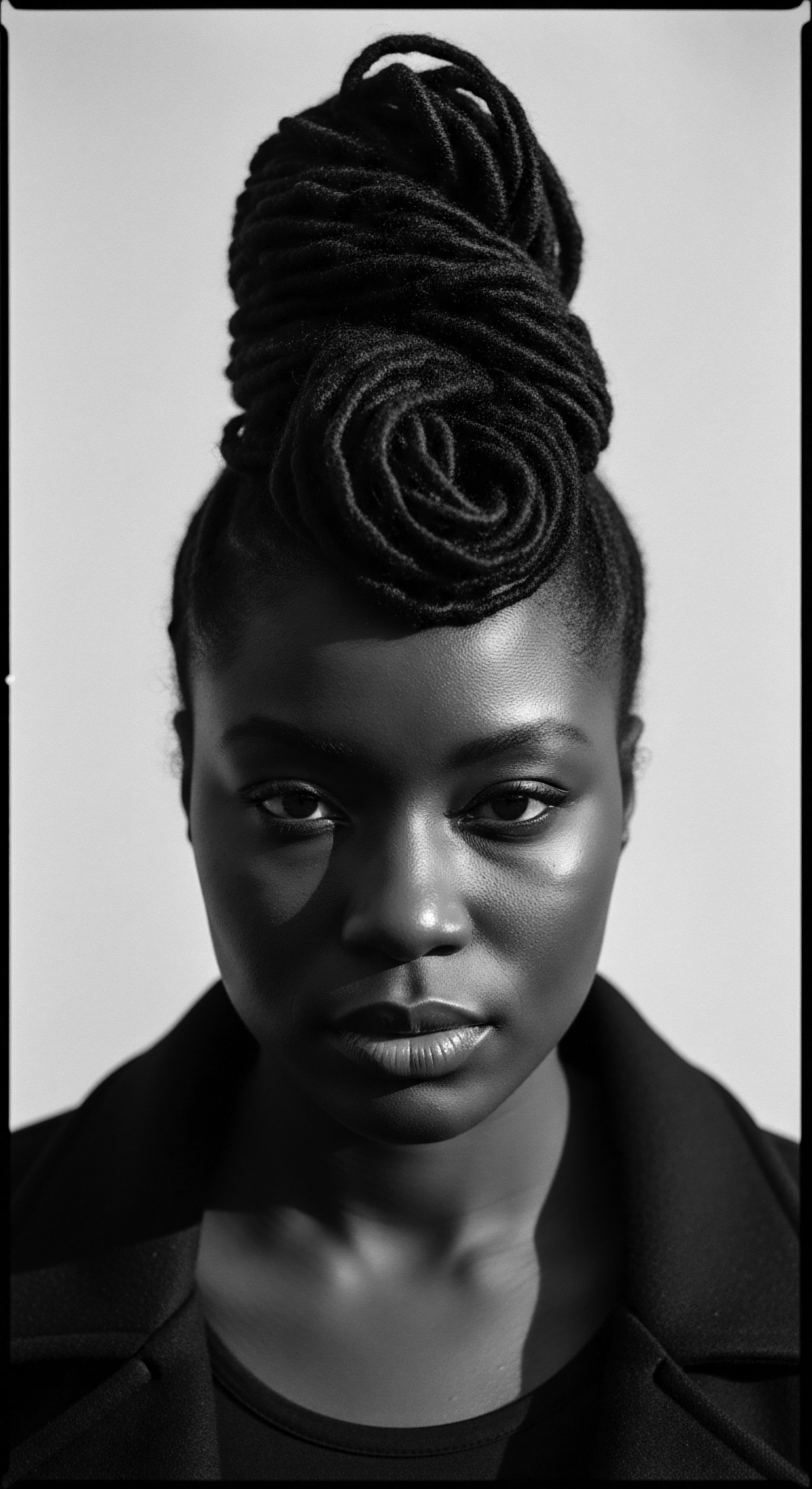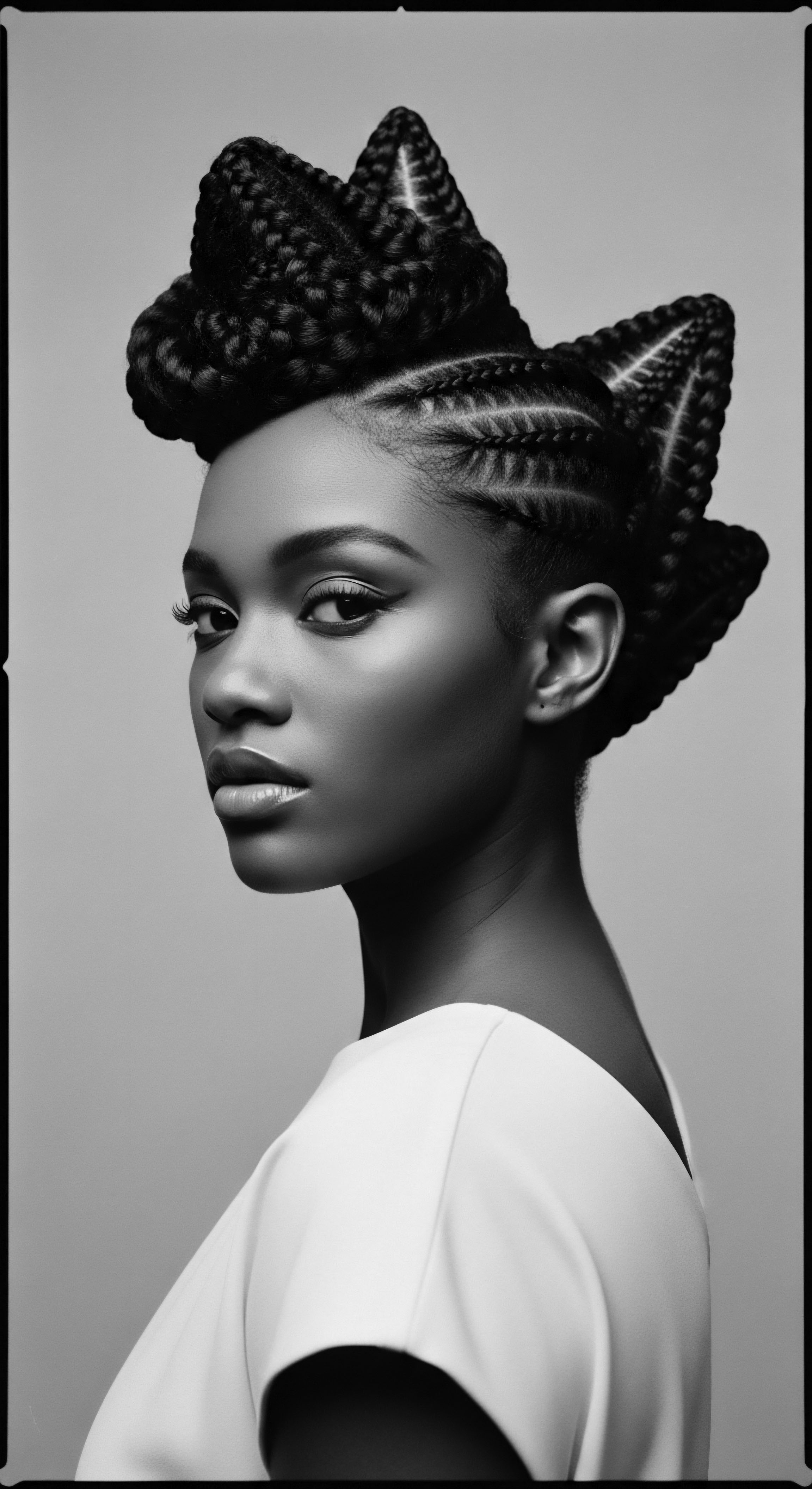
Roots
Consider the gentle whisper carried on ancestral winds, a quiet knowing that predates laboratory analyses and microscopic scrutiny. For generations, the care of textured hair has been more than a regimen; it has always been a language spoken through touch, a wisdom passed from elder to child, a testament to resilience and profound beauty. This is not a story of mere strands, but a narrative woven from the very soul of Black and mixed-race communities, a living archive of heritage expressed through every coil, kink, and curl. To ask how traditional hair care methods align with modern scientific understanding of textured hair is to seek the echoes from the source, to uncover the elemental truths long understood by those who lived intimately with their hair’s inherent nature.
The journey into understanding textured hair begins at its fundamental biology, a study deepened when approached through the lens of ancestral wisdom. Long before microscopes revealed the elliptical cross-section of a coily strand or the irregular distribution of disulfide bonds, traditional practitioners observed its unique thirst, its tendency to resist certain manipulations, and its powerful capacity for shrinkage. They recognized its distinct anatomy, not with scientific diagrams, but through generations of careful observation and skilled hands.

The Curl’s Blueprint From Ancient Times
The human hair shaft, at its core, is a complex protein structure. For textured hair, this structure possesses a particular helical twist and an often flattened or elliptical cross-section. This unique morphology contributes to its remarkable curl patterns, from broad waves to tightly packed Z-coils. Early communities, without knowing the precise scientific terms, recognized these differences instinctively.
They knew that a tightly coiled strand behaved differently from a straight one, requiring distinct approaches to detangling, cleansing, and conditioning. This intuitive understanding of hair’s inherent “blueprint” guided their practices.
Consider the practices rooted in various African societies that predate colonial influences. Women of the Ovahimba (Himba) people in Namibia, for instance, have traditionally applied a reddish paste called Otjize to their hair and skin. This paste, a mixture of butterfat, ochre, and aromatic resins, serves multiple purposes ❉ it cleanses, moisturizes, protects from harsh sun, and even acts as a symbolic adornment.
While modern science would explain the ochre’s properties as a natural mineral offering UV protection and the butterfat as a lipid barrier against moisture loss, the Himba’s ancestral practice arrived at these benefits through generations of practical application and inherited knowledge, without formal chemical analysis (Jacobson, 2011). This demonstrates an alignment where intuitive observation led to effective solutions, mirroring the aims of modern scientific inquiry.
Ancient practices, often guided by intuitive observation, frequently arrived at solutions that modern science now explains.

Whispers of Hair’s Life Cycles
Hair growth cycles – anagen, catagen, and telogen – are universal, yet their nuances are particularly felt within textured hair communities. The fragility at certain points in these cycles, the varying densities across the scalp, and the influence of diet and environment were understood not through clinical trials but through sustained, communal care. Traditional diets, rich in locally sourced nutrients, often provided the very building blocks for healthy hair growth, unknowingly supporting the keratin synthesis modern science now details. The emphasis on gentle manipulation and protective styles, a common thread across many ancestral practices, implicitly recognized the telogen phase’s delicacy, minimizing breakage and preserving length.
The lexicon of textured hair has evolved, too, reflecting both scientific progression and deep cultural roots. While modern classification systems (like Andre Walker’s typing) offer a numerical framework for curl patterns, ancestral communities often used descriptive terms tied to nature, texture, or even familial lineage to distinguish hair types. These descriptive terms, though less precise in a scientific sense, carried profound cultural weight, reflecting the reverence and intrinsic understanding of hair within its communal context.

The Ancient Art of Hair Hydration?
One enduring alignment is the profound recognition of textured hair’s constant need for moisture. Because of its coily structure, natural oils produced by the scalp struggle to travel down the entire length of the hair shaft, leaving the ends particularly vulnerable to dryness. This scientific reality was met by ancestral solutions ❉
- Oils ❉ Various botanical oils – coconut, shea, castor, olive – were (and remain) central. These plant-derived lipids, rich in fatty acids and vitamins, are scientifically proven emollients and occlusives, sealing moisture and providing nourishment.
- Butters ❉ Shea butter, cocoa butter, and mango butter, long before their chemical compositions were broken down, were prized for their emollient and protective qualities, their ability to soften and shield the hair.
- Humectants ❉ Natural humectants like honey or aloe vera were used in various concoctions, intuitively drawing moisture from the environment, a mechanism now understood at a molecular level.
These traditional applications, often performed with intention and ceremony, served to counteract the inherent dryness of textured hair, a scientific fact that has driven much of modern hair care product development. The continuity of these practices, from ancient remedies to contemporary formulations, highlights a deep, unbroken lineage of care.
The knowledge embedded within these practices speaks to a deep, living understanding of hair’s requirements. It’s a heritage that continually shapes how we approach textured hair today, bridging centuries of wisdom with contemporary insights.

Ritual
The transformation of textured hair, from its raw state to an adorned crown, has always been a ritualistic journey, a creative expression steeped in cultural meaning. These rituals, whether for daily maintenance or ceremonial preparation, were never arbitrary; they were informed by an intimate understanding of the hair’s physics and needs, echoing through generations. Modern science now offers granular explanations for the efficacy of these time-honored techniques, illustrating how ancestral ingenuity anticipated today’s cosmetic chemistry and trichology.
Protective styles, a cornerstone of Black and mixed-race hair care heritage, exemplify this profound alignment. Braids, twists, and cornrows were not simply fashionable; they were a strategic defense against environmental aggressors and daily manipulation, preserving hair length and integrity. The scientific understanding behind this is clear ❉ minimizing friction, locking in moisture, and providing a stable structure that reduces mechanical stress on delicate strands. Each coil and braid, a testament to ancestral mastery, speaks volumes of an intuitive grasp of hair mechanics.

Protective Styles ❉ An Ancient Shield?
Consider the widespread practice of cornrows. Beyond their aesthetic appeal, cornrows served various practical and cultural purposes across African societies. They could signify marital status, age, tribal identity, or even communicate specific messages. For individuals subjected to forced migration during the transatlantic slave trade, cornrows sometimes became a means of survival, hiding seeds for planting or even gold.
This historical context reveals a practicality that aligns with modern understanding of hair health. By braiding the hair close to the scalp, cornrows reduce tangling, breakage, and exposure to harsh elements, thus preserving the hair’s overall health and enabling length retention. This inherent protective function, recognized intuitively by ancestors, is now a scientifically validated approach to minimizing hair damage.
Protective styles, born from ancestral necessity, offer tangible scientific benefits by shielding delicate strands from environmental harm.
The choice of tools, too, bears witness to this alignment. Early combs fashioned from wood or bone, often wide-toothed, reflect an intuitive understanding of detangling delicate, coily strands. These tools minimized snagging and tearing, a principle that modern wide-tooth combs and detangling brushes emulate. The preference for smooth materials over rough ones also aligns with modern insights into cuticle health; friction from harsh surfaces can lift the cuticle, leading to damage and frizz.

The Dance of Definition ❉ Natural Styling
Natural styling and definition techniques, deeply rooted in heritage, find validation in modern scientific principles. The “wash and go,” for example, which emphasizes hydrating and defining natural curl patterns, often employs techniques like finger coiling or shingling. These methods ensure even product distribution and help individual curl clumps form, reducing frizz and enhancing visual definition. This aligns with the scientific understanding of hydrogen bonds within the hair’s cortex.
Water breaks these bonds, allowing the hair to be reshaped; as it dries, the bonds reform, locking the curl pattern in place. Traditional methods, such as applying water and herbal infusions then allowing hair to air dry in specific configurations, intuitively worked with this very principle.
The history of hair extensions and wigs also reflects a deep understanding of transformation and aesthetic expression, extending back to ancient Egypt where wigs signified status and hygiene. While modern extensions offer vast versatility in length and style, their foundational purpose—to enhance, protect, or alter appearance—remains constant. The meticulous crafting of ancient wigs, often from human hair or plant fibers, speaks to a sophisticated understanding of hair manipulation and adornment that mirrors today’s wig-making artistry.
Even in the realm of heat styling, a modern innovation, there are echoes of historical practices. While direct heat is a contemporary concern for textured hair, historical methods of straightening often involved pressing combs heated over fire. The underlying principle, the temporary alteration of hydrogen bonds through heat, is the same. Modern heat protectants and precise temperature controls aim to mitigate the damage caused by these thermal changes, a refinement of a historically recognized transformative technique.
The journey from ancient practices to contemporary hair care rituals reveals a continuum of knowledge. Each traditional method, each chosen tool, carries within it an implicit understanding of textured hair’s unique needs, a wisdom now articulated and expanded by scientific inquiry.
| Traditional Method Hair Oiling/Greasing |
| Core Principle (Historical) Nourishment, protection, sheen. |
| Modern Scientific Alignment Seals cuticle, reduces friction, adds lipids, minimizes water loss. |
| Traditional Method Protective Styling (Braids/Twists) |
| Core Principle (Historical) Length retention, less daily manipulation. |
| Modern Scientific Alignment Reduces mechanical stress, minimizes breakage, shelters ends. |
| Traditional Method Herbal Rinses |
| Core Principle (Historical) Cleansing, scalp health, shine. |
| Modern Scientific Alignment Astringent, pH balancing, anti-inflammatory properties of botanicals. |
| Traditional Method These alignments show a continuous thread of practical wisdom, validated by contemporary understanding. |

Relay
The care of textured hair has always extended beyond mere aesthetics; it is deeply entwined with holistic wellbeing, nighttime rituals, and the enduring quest for solutions to common hair challenges. This comprehensive approach, passed down through generations, finds significant validation and refinement in the scientific insights of today. The seamless relay of ancestral wisdom into modern understanding provides a rich tapestry of care that addresses the whole person, not just the hair on their head.
Building a personalized regimen for textured hair often draws inspiration from ancestral wisdom. The layering of products – a traditional practice of applying oils after water-based moistures – aligns perfectly with the scientific principles of hydration and sealing. Water provides the initial hydration, penetrating the hair shaft, while the oil or butter then forms a protective barrier, preventing that moisture from escaping. This simple yet highly effective technique, common in many ancestral communities, is now a cornerstone of modern textured hair regimens, often referred to as the LOC Method (liquid, oil, cream) or LCO Method (liquid, cream, oil).

Why Is Nighttime Care a Sacred Ritual?
Perhaps no aspect of textured hair care so strongly bridges traditional practice and scientific understanding as the nighttime sanctuary. The use of head coverings – bonnets, scarves, durags – is not a recent phenomenon. Across diverse cultures, head wraps have served purposes ranging from modesty and protection to symbols of status and cultural identity. For textured hair, these coverings play a scientifically validated role ❉ they protect delicate strands from friction against rough pillowcases, which can lead to breakage, frizz, and moisture loss.
Silk and satin, prized for their smooth surfaces, minimize this friction, preserving the hair’s natural moisture balance and structural integrity throughout the night. This ancestral wisdom, intuitively recognizing the nightly need for protection, is a practice every modern hair scientist would endorse.
Consider the cultural and historical weight of the headwrap. In many West African societies, head wraps were elaborate expressions of art and social standing. During the transatlantic slave trade, laws like the Tignon Laws in Louisiana attempted to strip Black women of their adornment and identity, forcing them to wear simple tignons. Yet, these acts of suppression were often met with defiance, as women found ways to transform even simple coverings into statements of beauty and resilience.
Today, the bonnet continues this legacy, offering practical protection while carrying generations of cultural resonance. The science of friction reduction and moisture retention simply affirms the brilliance of an ancestral practice born from necessity and a deep understanding of textured hair’s vulnerability.
The consistent use of smooth head coverings at night is a venerable practice, affirmed by science for its role in preserving textured hair’s delicate structure.

Traditional Ingredients ❉ Science’s Ancient Allies?
A deep dive into traditional ingredients reveals a remarkable alignment with modern scientific understanding of their properties and benefits for textured hair. Many botanicals used for centuries are now subjects of rigorous scientific study, validating their efficacy.
- Aloe Vera ❉ Used for its soothing and moisturizing properties across ancient civilizations. Modern science confirms its rich composition of vitamins, enzymes, and polysaccharides, which condition and heal the scalp.
- Fenugreek ❉ A staple in Indian hair care traditions, often used to promote growth and reduce shedding. Research indicates its potential for stimulating hair follicles and providing anti-inflammatory benefits to the scalp.
- Chebe Powder ❉ Originating from Chad, this blend of herbs is traditionally used to strengthen hair and prevent breakage. Its efficacy is attributed to its ability to create a protective coating around the hair shaft, minimizing manipulation and loss, a physical barrier principle understood in material science.
- Black Soap (African Black Soap) ❉ Traditionally used for cleansing skin and hair. Its gentle, plant-derived ingredients offer effective cleansing without stripping, aligning with modern preferences for sulfate-free, mild cleansers.
These examples illustrate how ancestral communities, through trial, error, and shared wisdom, identified substances with properties that modern chemistry can now isolate and explain. The application of these ingredients in a holistic manner, often combined with massage and intention, further amplifies their benefits.

Addressing Challenges with Inherited Wisdom
Common textured hair challenges, such as dryness, breakage, and scalp conditions, were addressed in traditional contexts with remedies that often hold up to modern scrutiny. Dandruff, for instance, was often treated with herbal concoctions possessing antifungal or antibacterial properties, an intuitive approach to balancing the scalp microbiome. Hair loss was met with stimulating massages and nutrient-rich applications, recognizing the connection between scalp health and hair growth.
This continuous relay of knowledge, from ancient wisdom to contemporary scientific insights, reveals not a contradiction, but a profound conversation. Traditional practices, often born from necessity and deep connection to natural resources, laid the groundwork for our understanding of textured hair. Modern science, in turn, provides the language to explain the ‘why’ behind these time-honored methods, enriching our appreciation for the enduring brilliance of heritage.

Reflection
The journey through the intricate world of textured hair, from its elemental biology to its profound cultural expressions, reveals an enduring narrative of heritage. It is a story where the echoes from the source – ancestral wisdom gleaned through generations of intimate care – meet the precise language of modern science, not in opposition, but in harmonious affirmation. The very ‘Soul of a Strand’ is found in this continuity, a living archive of resilience, beauty, and ingenious adaptation that spans epochs.
Our exploration has illuminated how traditional hair care methods, often considered ‘folkloric’ or simply ‘old ways,’ are, in fact, powerful testaments to astute observation and a deep, intuitive understanding of textured hair’s unique requirements. The reverence for natural ingredients, the purposeful design of protective styles, the sacredness of nighttime rituals – each practice carries a scientific logic that, though unarticulated in chemical equations, was lived and breathed by those who came before us. This shared ancestry in hair care invites us to not just observe but to partake in a legacy, to honor the hands that tended, the voices that taught, and the wisdom that has sustained communities through time.
As we look ahead, the textured hair journey remains one of discovery, innovation, and profound connection. It beckons us to remember that beneath every scientific explanation lies a history, a culture, and a spirit, affirming that the path to true hair wellness is always rooted in recognizing and celebrating its remarkable heritage.

References
- Tharps, Lori L. and Ayana Byrd. 2001. Hair Story ❉ Untangling the Roots of Black Hair in America. St. Martin’s Griffin.
- Jacobson, Margaret. 2011. Ochre and Identity ❉ An Ethnographic Account of the Himba of Northwest Namibia. University of Cape Town.
- Byrd, Ayana D. and Lori L. Tharps. 2014. Hair Story ❉ Untangling the Roots of Black Hair in America. St. Martin’s Press.
- Powell, Janice N. 2013. The Hair Commandments ❉ The Ultimate Guide to Fulfilling Your Hair’s Potential. Lulu.com.
- Banks, Ingrid. 2000. Hair ❉ A Cultural History. University of Chicago Press.
- Holder, Geoffrey. 1974. African Ceremonies. Harry N. Abrams.
- Tetteh, Lydia K. 2008. Natural Hair Care & Styling ❉ Traditional & Contemporary Techniques for Healthy Hair. Inner Traditions.
- Robbins, Clarence R. 2012. Chemical and Physical Behavior of Human Hair. Springer.
